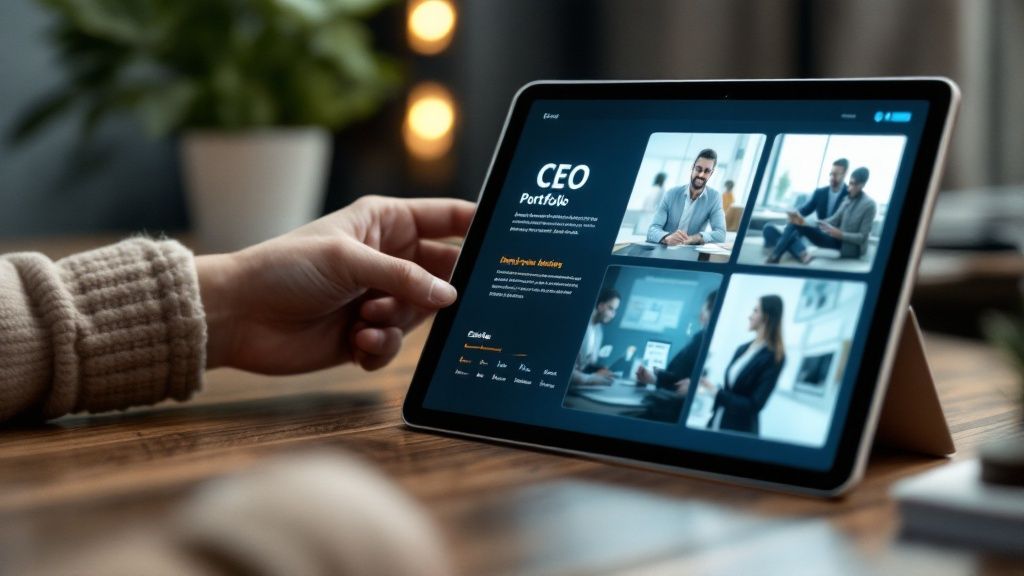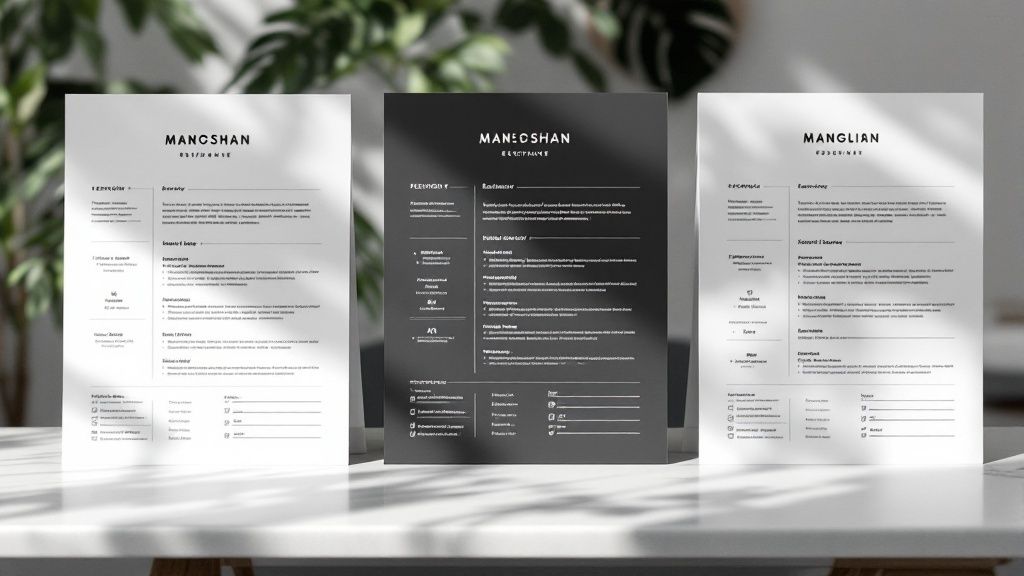The Evolution of Thought Leadership Content

The landscape of thought leadership content has changed dramatically in recent years. Modern audiences want more than just articles claiming expertise – they seek genuine insights and practical value they can apply. Companies need to rethink how they create and share knowledge with their target readers.
From Expert to Authority: A New Era of Value
Today's successful thought leaders do more than showcase what they know – they empower their audience with actionable wisdom. Rather than basic explanations, they explore deeper implications and ethical considerations of industry topics. This approach builds real credibility and creates meaningful engagement. Smart companies now use data and research to understand exactly what their audience needs and values.
The numbers tell an interesting story about thought leadership's growing importance, especially in B2B marketing. A recent B2B Thought Leadership Report found that 56% of marketers planned to create more thought leadership content. However, only 26% rated their current programs as "very successful," while 65% saw "moderate success." This gap shows how challenging it is to create content that truly resonates with decision-makers. For more industry data, check out the latest thought leadership statistics and trends.
Embracing Emerging Trends in Thought Leadership
Key trends shaping effective thought leadership include:
- Personalization: Creating content that speaks to specific audience needs
- Interactive Content: Using polls, quizzes and Q&As to boost engagement
- Multi-Platform Distribution: Sharing across social media, podcasts and webinars
- Authentic Storytelling: Building emotional connections through real examples
The path forward is clear – thought leadership needs to be authentic, data-informed and laser-focused on providing genuine value to target audiences. Companies that embrace these shifts and create truly helpful content will see the best results from their thought leadership efforts.
Building Your Strategic Thought Leadership Framework
A strong thought leadership content strategy is like building a house – it requires a solid foundation and careful planning. This framework becomes your blueprint, guiding every content decision while keeping your business goals in focus.
Identifying Your Unique Perspective
What truly sets your business apart? For example, Bhavik Sarkhedi & Co. blends storytelling skills with strategic positioning to create something special. Your unique approach should shine through in everything you create – like a signature dish that keeps customers coming back.
Deep Dive Into Audience Research
Getting to know your audience is essential. Through surveys and social media monitoring, you can understand their key challenges and information needs. Good audience research lets you create content that speaks directly to their interests and problems, much like a custom-tailored suit fits perfectly.
Developing a Sustainable Content Calendar
Regular, high-quality content builds trust and expertise. A well-planned content calendar helps you maintain momentum while staying flexible enough to cover emerging industry topics. Think of it as your content roadmap – it keeps you focused while allowing room to explore new paths.
Creating Topic Clusters and Establishing Authority
Build your authority by focusing deeply on specific topics. For instance, if Bhavik Sarkhedi & Co. wanted to own the "CEO personal branding" space, they might create related content about writing, speaking, and social media presence. This focused approach makes you the go-to source, similar to building a specialized library that people return to again and again.
Balancing Promotion and Authenticity
While brand visibility matters, authentic value matters more. Recent research shows that 66% of decision-makers have noticed more thought leadership content than ever before. Standing out requires genuine insights and a real desire to help your audience. Think of it like building any relationship – trust grows through consistent, honest interactions.
A clear framework helps you create thought leadership content that connects with readers, builds credibility, and delivers business results. With these building blocks in place, you can establish your brand as a trusted voice in your field.
Crafting Content That Drives Business Decisions

The best thought leadership content does more than share information – it moves people to act. By understanding your audience's needs and crafting compelling stories in the right format, you can create content that helps decision-makers take meaningful steps forward.
Understanding the Psychology of Decision-Makers
Business leaders face constant time pressure and information overload. To capture their attention, focus on their specific challenges and bottom-line impact rather than broad industry discussions. Show them exactly how your insights can solve their problems. This targeted focus makes your content immediately useful and establishes you as a trusted resource.
Optimizing Content Formats for Different Platforms
Each platform requires its own content approach:
- LinkedIn: Brief, insightful posts and active participation in industry discussions
- Twitter: Quick updates, real-time engagement, and links to detailed content
- Company Blog: In-depth articles, research, and case studies showing your expertise
- Industry Publications: Guest posts to build credibility with new audiences
Using multiple platforms helps you reach decision-makers where they already spend time.
Writing Techniques That Establish Credibility
Build trust by balancing expertise with accessibility. Use clear language instead of jargon. Support your points with real data and examples that show practical applications. Share relevant personal stories to connect with readers authentically. This combination of authority and relatability helps position you as a genuine expert.
The numbers confirm that thought leadership drives business results. According to IBM's research, 87% of CEOs make purchase decisions based on thought leadership content. The return on investment reaches 156%, far above typical marketing campaigns at 9-10%. Find more data in IBM's analysis. This shows how strategic thought leadership content can set your business apart and drive growth. When you understand decision-maker needs, match content to platforms, and establish credibility through strong writing, you create content that leads to meaningful business outcomes.
Measuring Impact and Optimizing Performance
A successful thought leadership content strategy needs more than just content creation – it requires measuring real impact and using those insights to improve. Let's explore how to build an effective measurement system to track and optimize your content's performance.
Defining Your Key Performance Indicators (KPIs)
Start by choosing metrics that directly connect to your business goals. Different objectives need different measurement approaches:
- Brand Awareness: Look at social media mentions, website visits, and media coverage to understand your content's reach
- Lead Generation: Track downloads, webinar sign-ups, and form submissions to measure interest from potential customers
- Sales Impact: Monitor how content engagement relates to actual sales conversions and analyze which content drives the most valuable leads
Using Data to Refine Your Content Strategy
Your metrics tell an important story about what works. When certain topics consistently generate more leads or engagement, that's a clear signal to create more content in those areas.
The right tools make measurement much easier. Google Analytics, Ahrefs, and SEMrush help track key metrics like page views, time on site, social shares, and backlinks. This data helps you understand your content's true reach and influence. Want to dive deeper into content measurement? Check out this helpful guide on thought leadership strategy.
Demonstrating Value to Stakeholders
A solid measurement framework helps prove the worth of your thought leadership content strategy to decision makers. Clear data about your program's impact makes it easier to get support and resources for future initiatives.
Regular reporting builds confidence in your thought leadership efforts and shows exactly how they benefit the business. Remember that consistent measurement and optimization are key to delivering real value through your content program.
Maximizing Content Reach and Influence

Creating excellent thought leadership content is just the first step. The real impact comes from getting that content in front of the right audiences at the right moments. Let's explore practical ways to expand your content's reach and influence.
Combining Owned, Earned, and Paid Media
Smart organizations use a balanced mix of different media channels. This includes:
- Owned media: Your company blog, social media accounts, and email newsletters
- Earned media: Press coverage, mentions by industry experts, and word-of-mouth
- Paid media: Targeted advertising and sponsored content
For example, you might share a blog post on your website, pitch it to relevant industry publications, and boost it through social ads to reach specific decision-makers in your field.
Building Authentic Partnerships and Leveraging Executive Platforms
Working with other leaders and companies can significantly boost your reach. Look for partners whose audiences align with yours but don't directly compete. Personal platforms like executive LinkedIn profiles and speaking opportunities help establish individual authority. Think of it as mutually beneficial promotion – you help each other reach new audiences.
Activating Internal Networks for Content Promotion
Your team members can be powerful advocates for your content. When employees share and discuss your thought leadership pieces on their personal networks, it adds credibility through personal endorsement. Give your team clear guidelines and make it easy for them to share content appropriately.
Exploring Emerging Distribution Channels and Repurposing Content
Stay open to new ways of sharing your ideas. Niche online communities, industry podcasts, and specialized platforms can help you reach engaged audiences. Make your content work harder by adapting it for different formats:
- Turn long articles into bite-sized social posts
- Create infographics from key statistics
- Record video summaries of written pieces
- Develop slide decks from detailed guides
This approach helps you connect with people who prefer different content formats while maintaining your core message. The goal is simple: share valuable insights with as many relevant decision-makers as possible to build your reputation as a trusted voice in your field.
Navigating Common Challenges and Pitfalls

Building a thought leadership content strategy takes careful planning, but challenges can still arise. Let's explore some common obstacles and practical solutions to help you succeed.
Maintaining Content Quality at Scale
As your content output grows, keeping quality consistent becomes essential. Create detailed content guidelines that outline your brand voice, style, and messaging standards. Put a solid editorial process in place with dedicated reviewers who can maintain high writing standards and catch any issues.
Managing Stakeholder Expectations
It's important to set clear goals and success metrics from the start. Regular updates and performance reports help keep stakeholders informed and aligned. Be upfront about what's achievable and how you'll measure progress to avoid misaligned expectations.
Staying Authentic While Meeting Business Objectives
Finding the right balance between authenticity and business goals is key. Focus on providing real value by addressing industry challenges and offering practical solutions. This builds trust more effectively than pure self-promotion. Share genuine insights that help your audience solve problems.
Overcoming Resource Constraints
Limited budget, time or staff? Focus your efforts on the channels and content types that resonate most with your audience. Make the most of existing content by repurposing it – turn webinars into blog posts or social media updates to maximize your resources.
Maintaining a Consistent Voice Across Contributors
With multiple content creators, keeping a unified voice takes work. Create a detailed brand voice guide covering tone, style and language preferences. Regular training and feedback sessions help contributors stay aligned with guidelines.
Adapting to Market Changes
The business landscape shifts quickly. Stay informed about industry trends and audience needs. Review and update your content calendar regularly to keep topics fresh and relevant. Be ready to adjust your approach as needed.
Ready to build your authority as a thought leader? Bhavik Sarkhedi & Co. provides expert guidance and tailored strategies to help you achieve your goals. Visit us today to learn more.




















